LPVOs have become a fast favorite for close to medium-range enthusiasts. Some call it a fad or something close to a cult-like following when it comes to comparing close-range optics. Other types of competitively styled sights include holographics, red dot & magnifier combinations, ACOGs, and I’ll even throw in the old iron sights in there with it too. With so many different styles of close to mid-range sighting systems, why go for an LPVO? We’re here to find out the pros and cons that come with LPVOs and what applications would be best if you’re in the market for one of these scopes.
Primary Arms was kind enough to send us this scope so we could test it out for an in-depth review. As with all our reviews, we try to always be objective and give the entire story.
Check Price at:
Overview
Primary Arms has done a fantastic job of putting efficiency and effectiveness into its LPVOs. Their acclaimed ACSS reticle is jam-packed with features that make this scope extremely versatile, yet still remain simple and uncrowded when you look through the glass.

If you look at Primary Arms’ website, this is a Fourth Generation optic, which I love seeing when reviewing scopes. Multiple generations mean that the company is at least adding and improving its scopes to better fit the consumer’s needs. There was a lot more to this scope than I had originally thought, which should be exciting. The durability, accuracy, and ease of use are exactly what I wanted to see out of an LPVO. Here were the first impressions I had after getting the scope in the mail.
First Impressions
This Primary Arms SLx 1-6×24 ACSS scope comes out of the box ready to be put in a set of rings (or a cantilever). Out of the box, it comes with flip caps already installed, and a battery for illumination already inside. Aside from that, there were the usual manuals in the box along with the cleaning cloth and some Allen wrenches for the turrets. No assembly was required, but I always recommend you give the screws that hold on your turret value caps a good tightening.
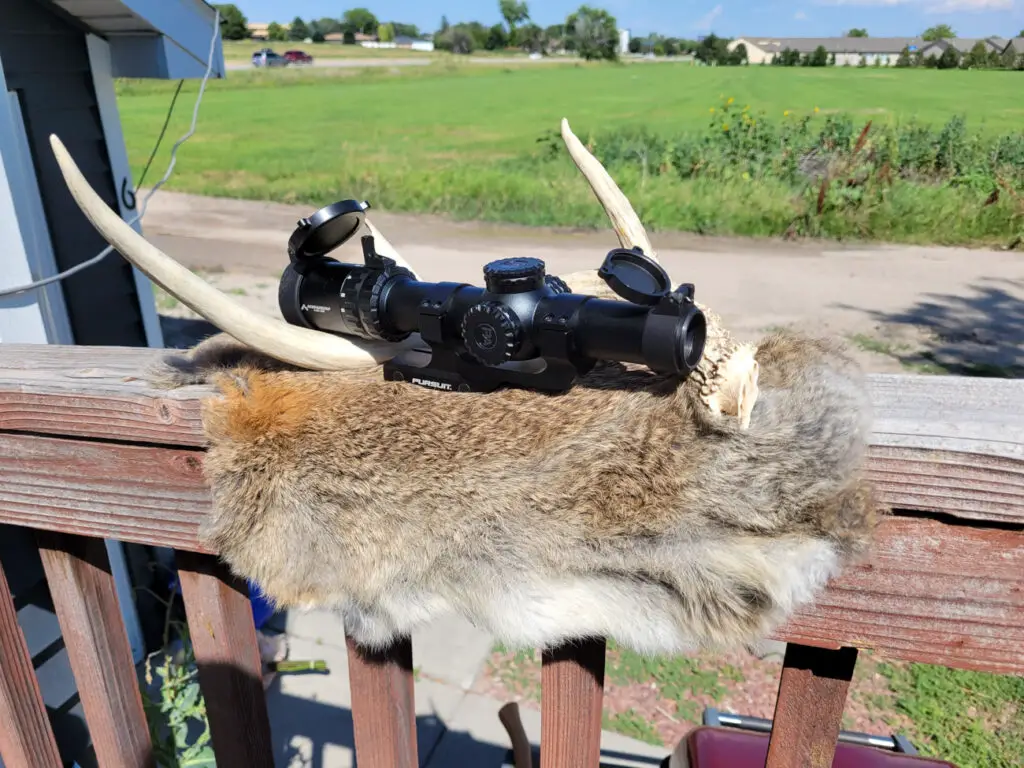
This scope was no exception, and even after tightening the set screws, the adjustment caps were still a little wobbly. I don’t plan on taking the covering caps off very much, so this isn’t a big deal that affects the function of the scope. However, the fact that they’re not firm and secured is the biggest downside of the optic.
Looking out of my kitchen window, there weren’t any observed differences in brightness, but I was very surprised by how in-focus everything was out to distance. It’s important to note that this optic does NOT have a parallax adjustment knob. There is a fast-focus eyepiece that’s meant to put the crosshair and the target in the same focus setting, but there’s nothing to adjust the overall focus of the scope.

I can see up to around 300 yards outside my window, and I was able to see out to that distance without noticing out-of-focus objects or negative visual affects. The fact that it can achieve this without a focus know is impressive. Hopefully, this first impression is a prediction for how the testing will go. Let’s see how the optic performed in our testing.
Accuracy & Tracking
A rifle scope is only as good as its accuracy. Tracking is one of the pickiest criteria for me with these reviews. For the box test that was conducted, each target on the paper was exactly 2 MILS from bullseye to bullseye. It was so satisfying to see that from the center target (which was already half an inch high and right from the exact center) the box test proved this scope to be as precise as a scope could be.

The turret clicks were a little too easy to adjust, however, and I had to make sure to take my time clicking to not risk any accidental double clicks from going too fast. I usually like to see heavier clicks, but that’s usually because exposed turrets require those heavy clicks. Since these are capped turrets, and this scope wasn’t exactly designed with turret adjustments in mind, I don’t mind that the clicks were light. Perhaps the light clicks were a result of the adjustment caps being loose (even after being tightened). The light clicks and wobbliness were probably the worst parts about the scope, but as I mentioned, since you won’t be running these turrets hardly at all it shouldn’t matter.

If you look at the picture of the box test, you’ll see that I zeroed on the center target, and started by going 1 MIL up before realizing the targets are 2 MILs apart. You’ll also see a stray shot on the bottom target, and that was from the sight-in process. Just thought I would explain some of the holes that weren’t part of the test.
The important part is that the SLx tracks exactly how it needs to. You won’t be cranking your scope adjustments on this scope, but you should at least have the confidence that the optic has that capability when you decide to put it in your cart. Even after it was dropped onto concrete, the turrets tracked and worked fine. Let’s get into some of the details surrounding that concrete drop and the durability results that came from that test.
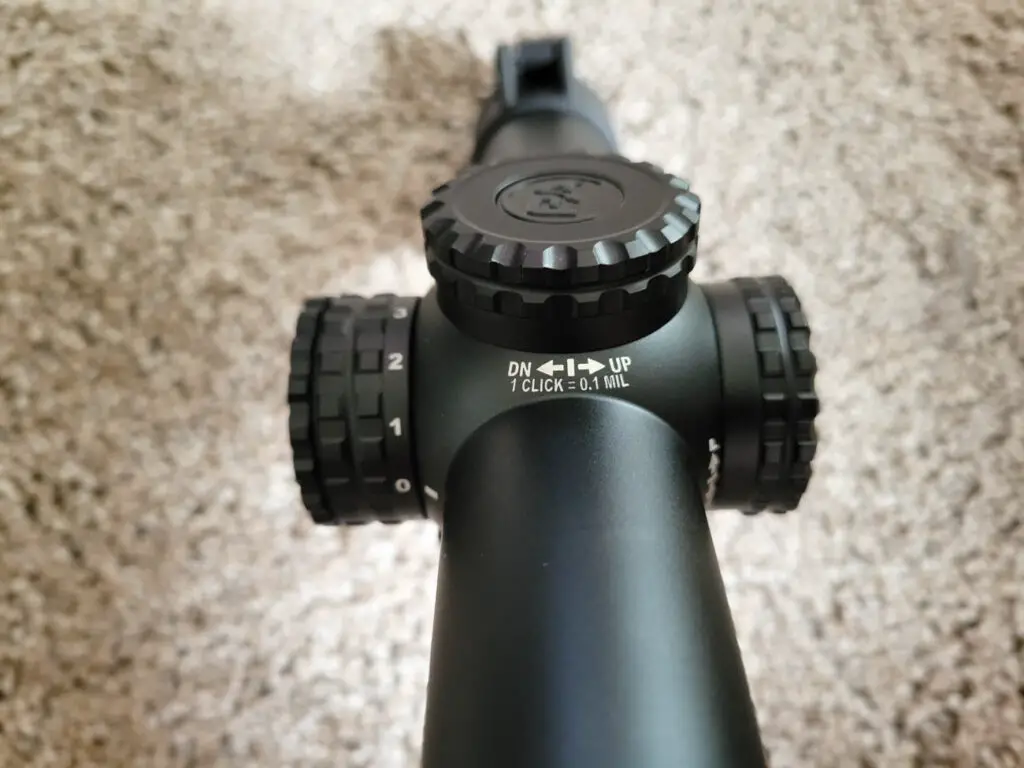
Durability
There’s no reason for me to coddle these scopes like they’re made of eggshells. My scopes are dropped from shoulder height to see how the body and tube hold up to being subjected to blunt force. This test is the most painful one for me to do, as I prefer to keep my glass in as good of shape as I can. It wouldn’t do anyone any good to buy this scope if it would break on a simple drop onto concrete.
So how did it do?

Primary Arms really outdid themselves when designing this scope. The turret caps are extremely low profile and wide, to the point that any blunt force that might land on the turret caps is distributed evenly. However, I was surprised to see that the lens caps actually took most of the force. Usually, the force of the drop is focused on the turret caps which results in scraping and gouging of the metal’s finish. The low profile of the turrets on this scope, combined with the lens covers that come installed when you take the scope out of the box makes it so that the scope body took no damage at all. There’s some scuffing on the plastic lens covers, but there’s no metal finish scraped off at all.
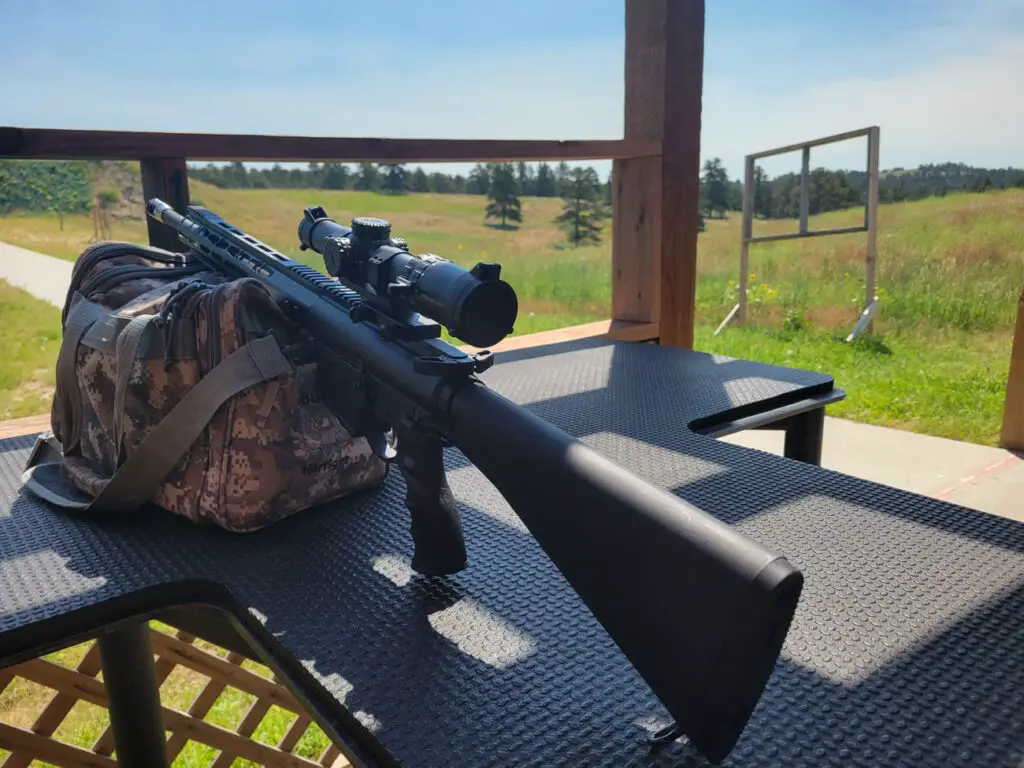
I couldn’t be happier with these results. I’m so used to high-magnification scopes with tall turrets that I wasn’t expecting the SLx to survive unscratched from the drop test. A 5-shot group was shot afterward to make sure it didn’t throw any zeroes off, and I was reassured when the group was right where it needed to be at 1 MOA. LPVOs are not known for their durability, but if they will remain unchanged after being dropped onto solid concrete, that’s a win.
I can account for my own clumsy ability to drop stuff onto concrete and not have to worry about the scope losing its function. Now that our testing is done, let’s get back to the features and capture the rest of this comprehensive review.
Features
Every optic demands a price, but what are you really getting for that money? At around $340 the SLx comes with features that were specifically chosen for an optic with practicality in mind. Some of those features include:
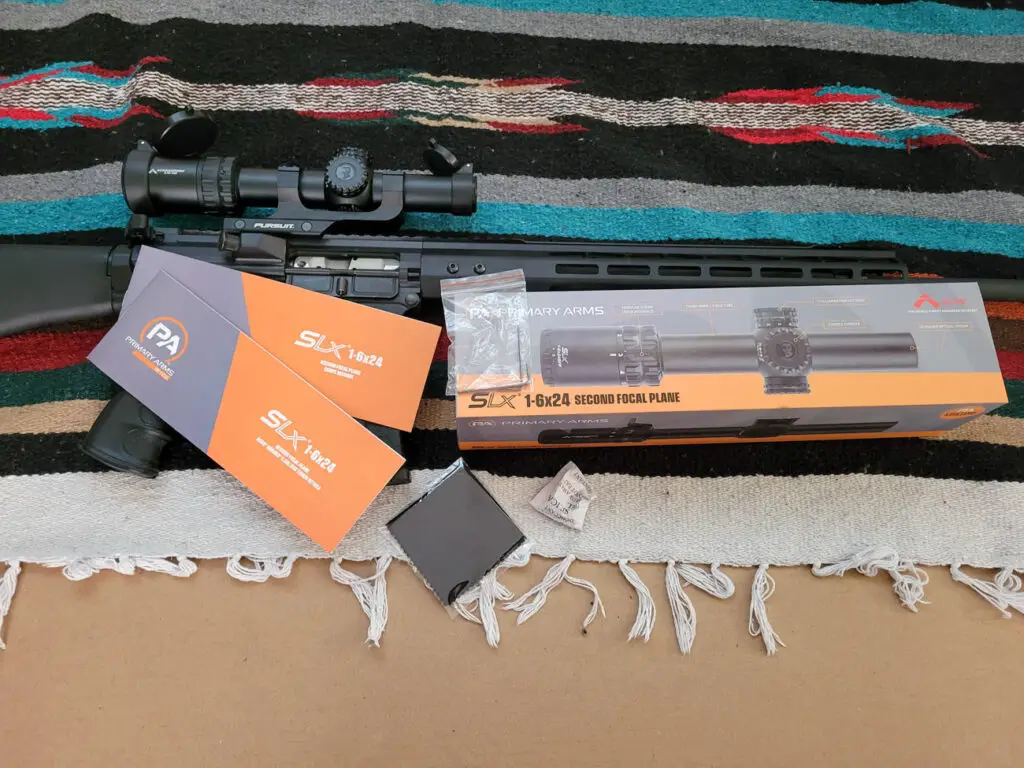
- Advertised 120 MOA elevation and windage adjustment
- The ACSS Aurora reticle
- Illuminated reticle
- Magnification throw lever
- 17.9 Ounces
- Capped, low-profile turrets
The first thing tested out of the box was if the scope actually had 120 MOA in travel with the turrets. This was more difficult to test than you would think, as the scope I have is measured in MILS as compared to MOA. Once measured, however, there were 54.2 MILS of travel in the Elevation turret and 53.0 MILS in the windage turret. The good news is that this is more than the advertised 120 MOA, but I also didn’t measure if the reticle moved with the turrets for every single click I measured. Either way, I have no doubt that the 120 MOA, which is quite a bit of adjustment in my book, is accurate.
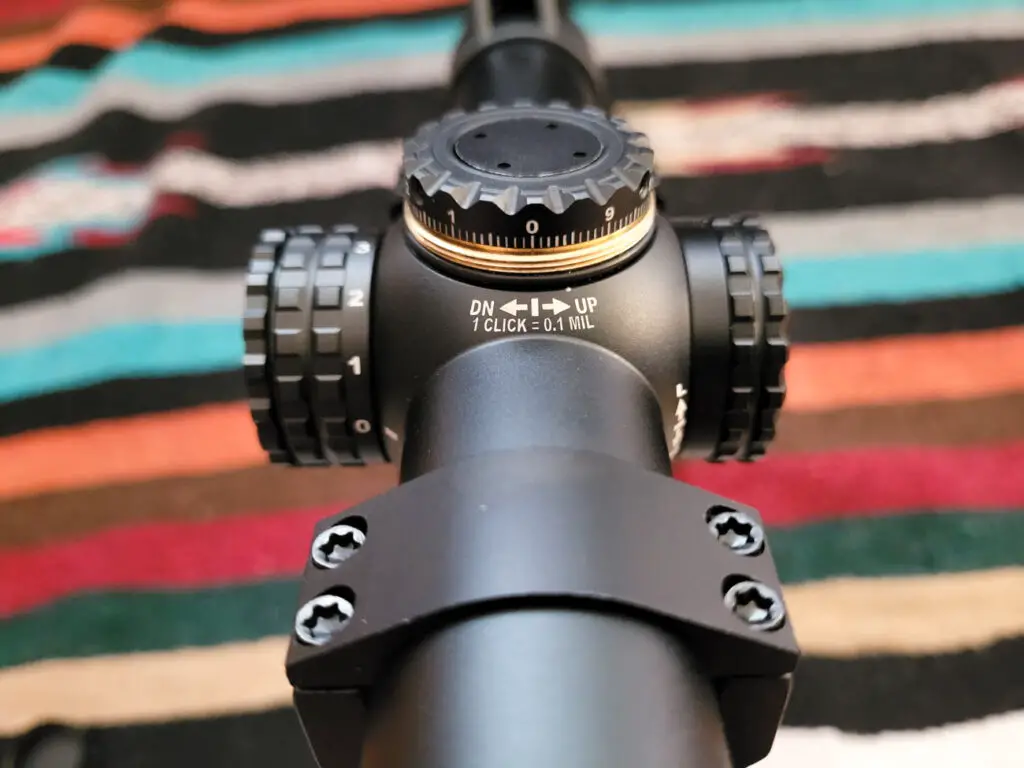
This scope is meant to be run off the reticle. That’s why it was a great decision for Primary Arms to cap the turrets and make them low profile. Once you have your zero set, there shouldn’t be any reason to dial unless you switch guns. The reticle included is comprehensive enough to take care of wind holds of up to 10 MPH winds and has elevation holds that take care of everything you need up to 800 yards. And for the metric-using audience, they even carry a Meters version of this scope. Overall, any other features that they could have put into this scope would have caused the price to increase. For $340 you’re getting an extremely well-thought-out optic.
Glass & Magnification Range
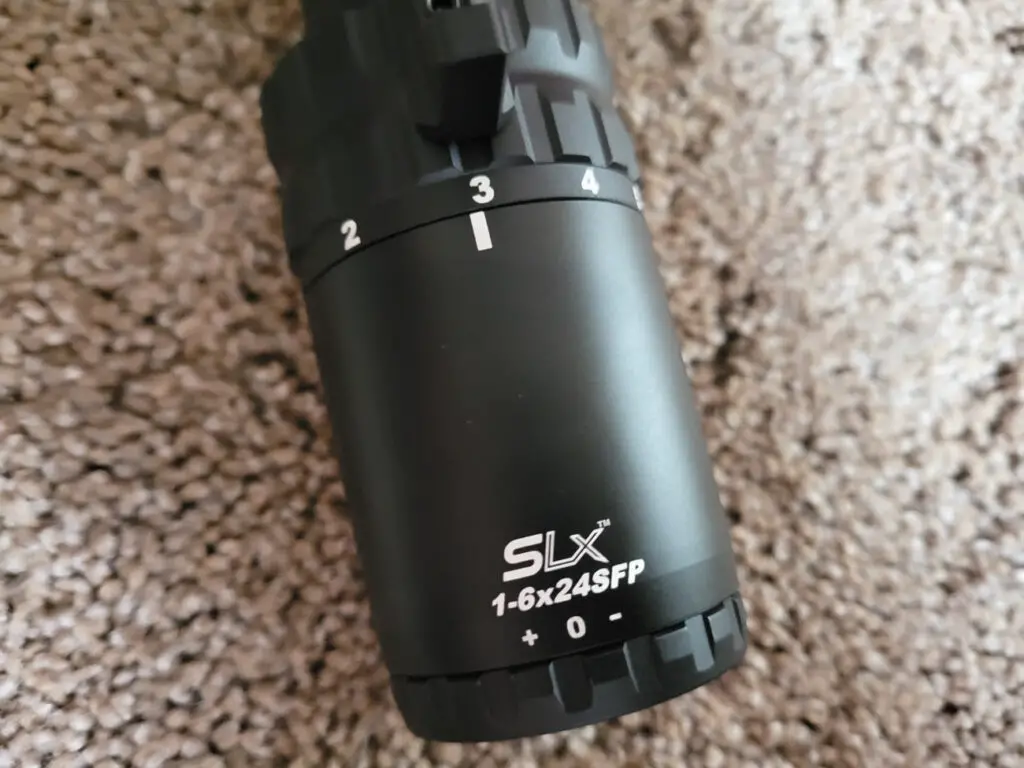
The magnification range on this LPVO is 1-6 which is a pretty good sweet spot if you ask me. Most LPVO manufacturers have issues going from 1-8 or 1-10 and maintaining good glass quality and clarity. With the top range of your magnification being 6 power, this is most likely the reason that Primary Arms is able to fit so much into a reticle that doesn’t crowd the glass.
While testing, I didn’t come off of 6 power the whole time. The chevron reticle was easy to zero and use, and the focus at 100 yards was perfect. Since this scope was tested on my custom-built AR-10 in .308 I was spotting my hits at 6 power with the SLx. Since this is a second focal plane optic, your elevation, and windage holds are accurate according to the manual that comes in the box. If I were using this for competitions that required both short and long-range engagements, I would have the capacity to use the 1x for close-up targets, and then simply go to 6x for the longer shots.

I didn’t expect amazingly perfect glass quality from a $340 scope, but the clarity from the SLx had no noticeable chromatic aberration or any negative effects. It will be interesting to see how this scope performs out to distance in time.
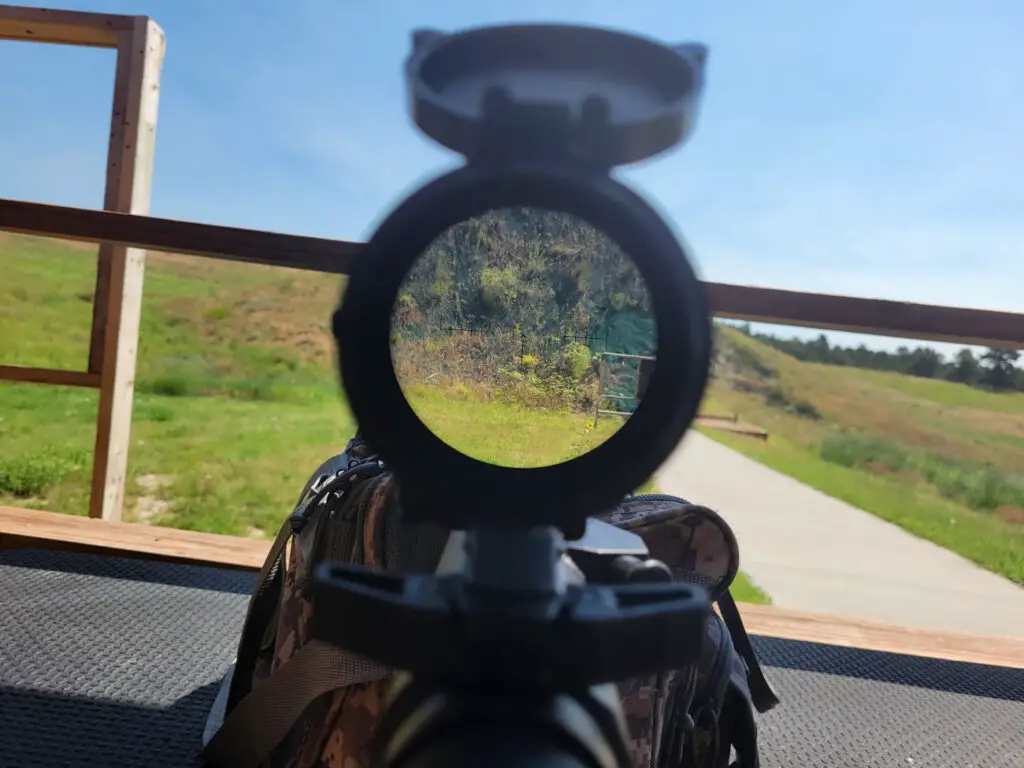
The ACSS Aurora 5.56/.308 Reticle
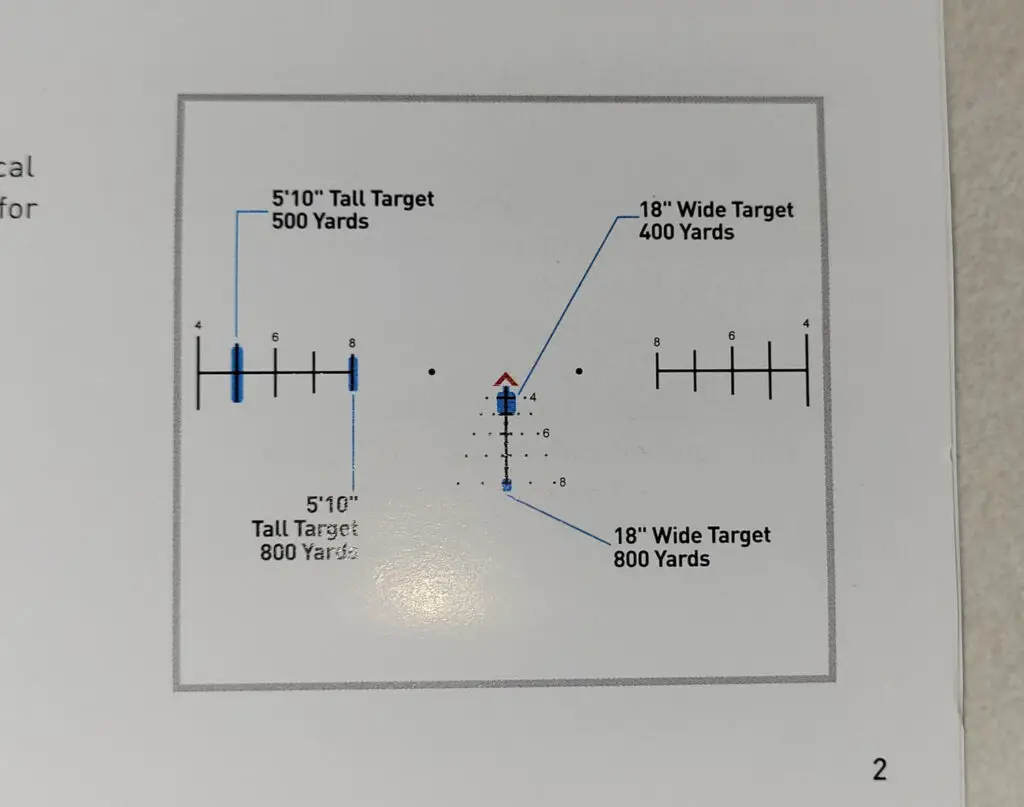
I never thought I could be so excited about a reticle. My usual choice for reticles is the classic Mil-Dot, but the ACSS is a genius innovation to competition-style rifle scopes. You can range targets with the elevation holds and the wind holds. The scope has holdovers for 5 MPH winds and 10 MPH winds with even more holdovers for “walking or running” targets. The elevation holdovers are also already built to allow you to hold for ranges from 100 to 800 in increments of 100 yards for both 5.56 and 308.

Ranging can be a really difficult skill to learn as a marksman, but it’s also extremely necessary to understand what range you’re shooting at. If you’re a hunter, you know more than anyone that a well-placed shot relies on your ability to know the ballistics of your rifle if you’re hunting at extended ranges. This ACSS reticle takes out the guesswork and allows you to use your reticle’s precalculated elevation holdovers instead of having to calculate, memorize, and implement DOPE (Data On Previous Engagements).
One problem I can see happening is if there are external variables that invalidate the holdovers in the reticle like wind, air pressure, elevation, and all the other weird values that affect a bullet’s point of impact. If you purchase this scope for the versatile reticle, make sure you practice with it as much as possible to learn how the reticle performs in conditions that make the reticle inaccurate.
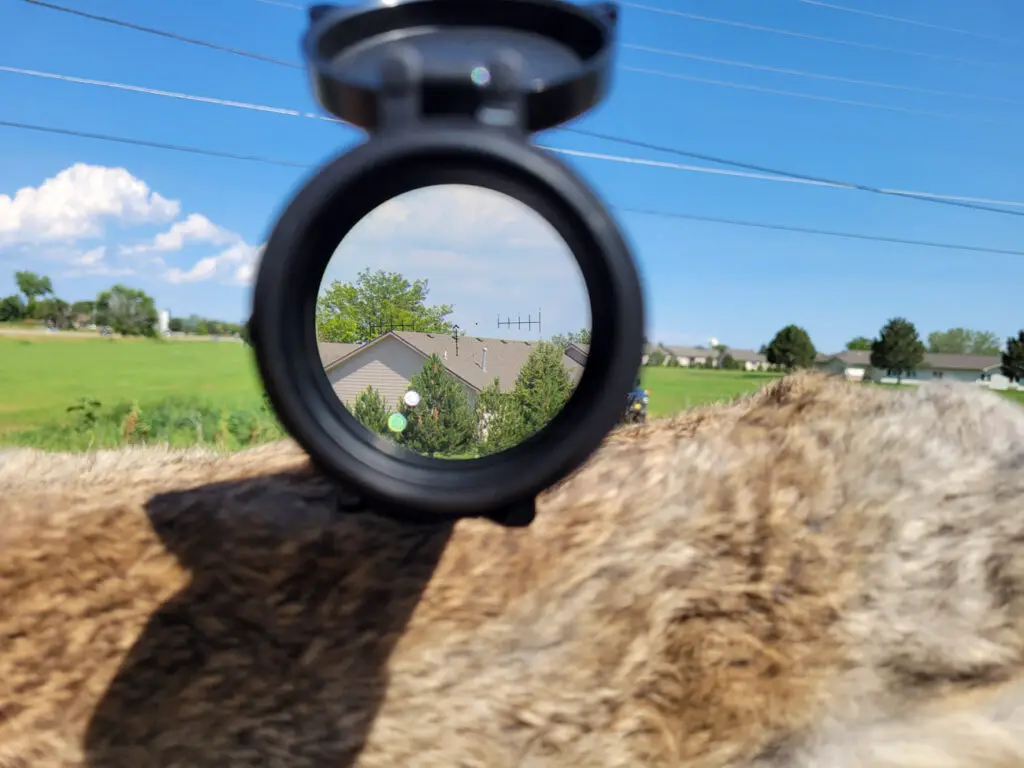
Overall, this reticle is extremely satisfying. Growing up, my learning optic was an ACOG that had a chevron-style reticle and I absolutely loved it. Also having experience with the MIL-Dot reticle, the ACSS Aurora was a great step up in expanding my experience with reticles. This will be a great sighting system to take out to a range that has varying targets at different distances to practice target acquisition and engagement at multiple distances at once.
Overall Pros & Cons
There is no such thing as a perfect optic and this one is no exception. There was a lot to like about the SLx, but there are a few cons that don’t sit the best with me. Both the good and bad will be reviewed in order to close out this review.
We’ll start with some of the pros we’ve already mentioned:
- $340 Price point
- Illuminated Reticle
- Versatile Reticle
- 120 MOA Travel
- 17.9 Ounces
- Very Low Profile
- Comes with Scope Caps & Battery
- Magnification Throw Lever
For the price point, this is the optic you would want to choose if you’re in the air about if you really want an LPVO or not. It’s lightweight, has a ton of travel in the turrets (if you even need it), and it’s an optic that’s meant to be hands-off. Illumination is usually something that comes with a price hike AND a sharp increase in weight, but 17.9 ounces is doing really good for an optic of this caliber.
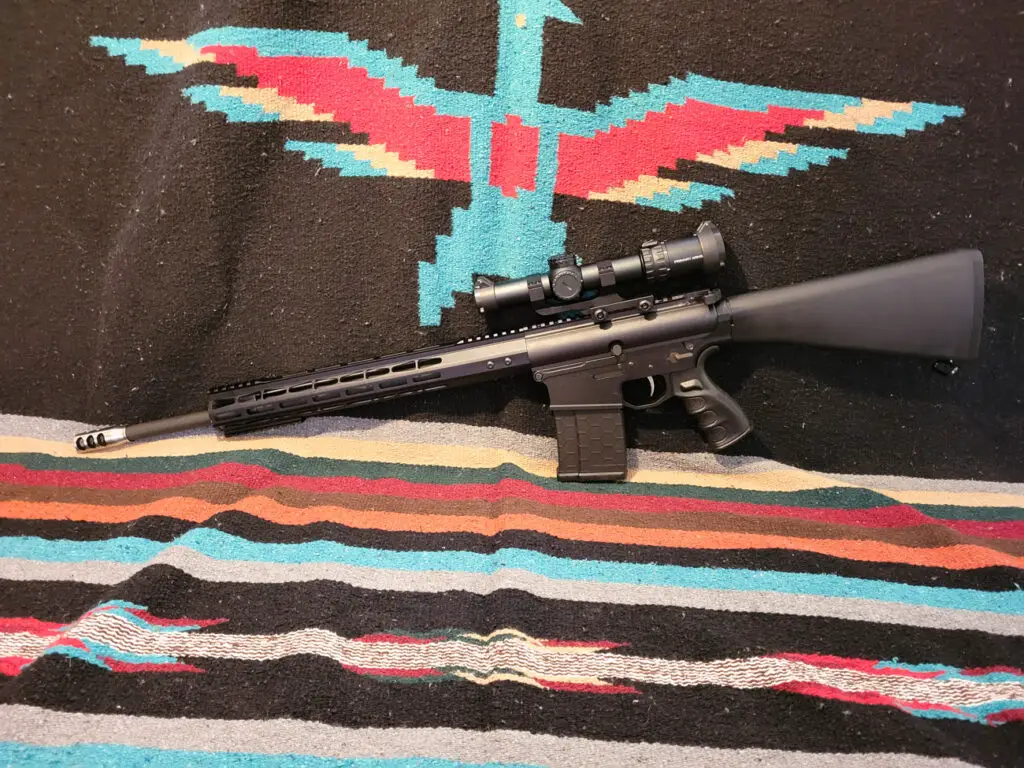
But enough about all the good stuff, let’s get into the cons I found when reviewing the SLx:
- No Parallax Adjustment
- Turret Lines are Tough to Line Up
- “Shaky” or Wobbly Turrets
- Eye Relief
I’ll keep eye relief as simply put as I possibly can. LPVOs are made for high-speed target acquisition and engagement. It’s ironic that there’s eye relief to begin with because you have to have consistent cheek weld and great fundamentals to find and stay in the eye relief of any scope consistently. I will say, however, that if you’re on 1x with this LPVO it is considerably easy to find, maintain, and reobtain the reticle as the eye box is always the most forgiving on the lowest magnification setting.
The turrets are the biggest con for me. As mentioned above, this won’t matter much because the turrets are meant to be capped and not touched. However, the fact that the lines that match up the exact MIL measurement on the turret don’t line up well with the parent mark could harm your dialing accuracy if you had to dial in the first place. The insecurity of the knobs also doesn’t fill me with confidence if I had to make a massive adjustment in a short amount of time. If you end up grabbing an SLx for your rifle, keep in mind it was made to keep the turrets capped, but also check on these cons and see if they’re consistent with your model as well. It’s something you need to keep an eye on if you’re using the optic in the long term.

The last thing I’ll say about the cons of this scope is that the lack of a parallax adjustment knob can potentially limit the capacity that this scope can be used. Is there a point in having holdovers for 800 yards if your optic can’t focus on targets that far? Unfortunately, I wasn’t able to test the scope out to distance, but after working with optics that didn’t have a parallax adjustment, I know that the focus and clarity of the optic will suffer once you start stacking on yards. As mentioned earlier in the article, the scope was very solid at up to 300. I would be curious how it will keep images focused once you’re shooting at 600-800 yards. Time will tell with the SLx, but if it’s great at focusing 100-300 yards, I would say that’s pretty impressive.
Best Application
Anyone thinking about getting into three-gun competition, or steel torso shooting has an excuse to try this LPVO out. The elevation holds also provide the tools you need for ranging, which allows for quick calculations which also lead to quick shots and follow-ups.
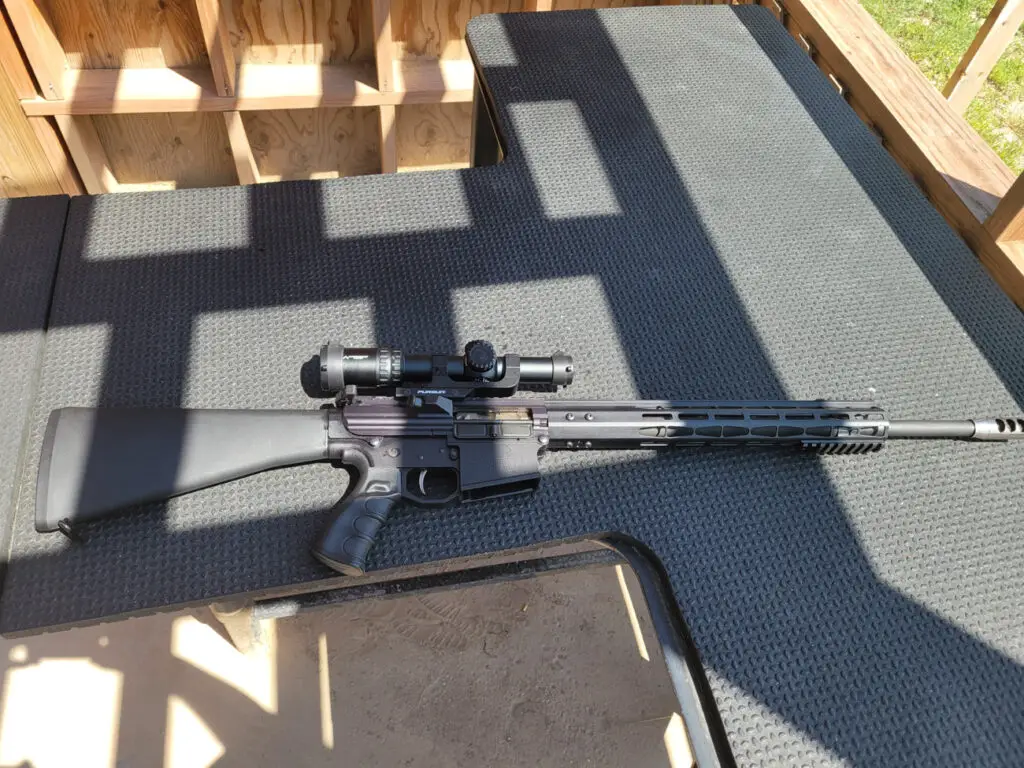
As a second focal plane optic, however, please keep in mind that you will have to keep the scope on 6 power for those holds to be accurate. Don’t mistake that for a con though, as this scope is better as a second focal plane. I wouldn’t put the SLx on a home defense weapon since I would have to operate within the eye relief window of the optic in order to have a sight to work with. This may not be the best for indoor tactical operations when your life is on the line, but it’s fantastic if you’re shooting paper, steel, or competition matches.
There’s no reason to believe you couldn’t stick this on a beginner rig to learn on. Using 6 power and a cartridge like .223 or .308 would allow someone to learn how to shoot long-distance without complicated reticles or multi-thousand dollar optics. It is worth mentioning that this scope’s holdovers are specifically made for .308 and 5.56 but you can purchase scopes made for different cartridges through Primary Arms. Even if this is a budget LPVO, it’s a fantastic value for the money if you’re looking at using it for the correct application. It’s tough for this scope to not look good on any AR-15 setup, but it does look a little wonky on a bigger LR-308 setup as you can see from the pictures.
Final Thoughts
As a “no maintenance” scope, the Primary Arms SLx 1-6×24 is a great entry into the LPVO market. Primary Arms is always modifying and creating new reticles to put into their optics, and I’m excited to see what they put into optics with different applications. LPVOs are difficult to shop for, as they’re mostly seen as a niche sighting system that has as many bad entries as it does good ones.
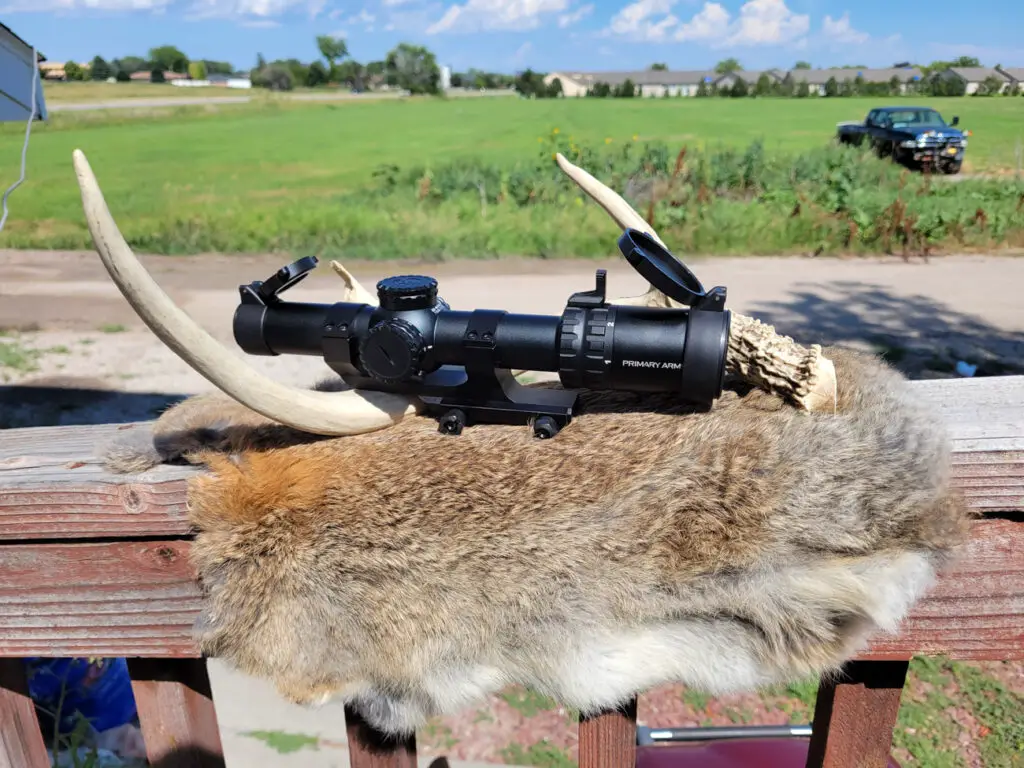
After putting this system through the wringer we can officially put the Primary Arms SLx on the “good entry” list. Maybe the turrets are mushy with light clicks, but I have all the confidence in the world that I can rely on this scope. I don’t intend on working the turrets now that it’s zeroed, so this is going to be a life-long entry into the gun safe. If you’re shopping for entry-level LPVOs, you need to put the SLx on your list of options.
This scope won’t disappoint, and it shows its value for the advertised price.
Check Price at:

Growing up, Buck was taught about firearm history and appraisal. Getting to know so many different firearm platforms eventually lead to his long-distance shooting exploration. While his main hunting past time is coyotes, he still find just as much satisfaction punching steel at distance. Every shot taken is with the purpose to become a better shooter.
